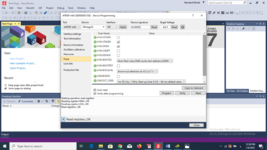johnny78
Full Member level 5

- Joined
- Jun 28, 2017
- Messages
- 270
- Helped
- 1
- Reputation
- 2
- Reaction score
- 5
- Trophy points
- 1,298
- Activity points
- 3,469
hi guys
i need to use the ATMEGA32 for a project but have a problem with Arduino library
i've downloaded this library & it works But the prblem is i have selected (External 16Mhz) as a clock source
& used the blink example to test the chip but the delay is 10x slower
so it blinks almost every 10 seconds instead of 1s
i have removed the crystal but it keeps working
so even the external source is using the internal oscillator
https://github.com/MCUdude/MightyCore
any suggested library or idea will be great or if you have a solution for this issue
thanks
Johnny
i need to use the ATMEGA32 for a project but have a problem with Arduino library
i've downloaded this library & it works But the prblem is i have selected (External 16Mhz) as a clock source
& used the blink example to test the chip but the delay is 10x slower
so it blinks almost every 10 seconds instead of 1s
i have removed the crystal but it keeps working
so even the external source is using the internal oscillator
https://github.com/MCUdude/MightyCore
any suggested library or idea will be great or if you have a solution for this issue
thanks
Johnny



